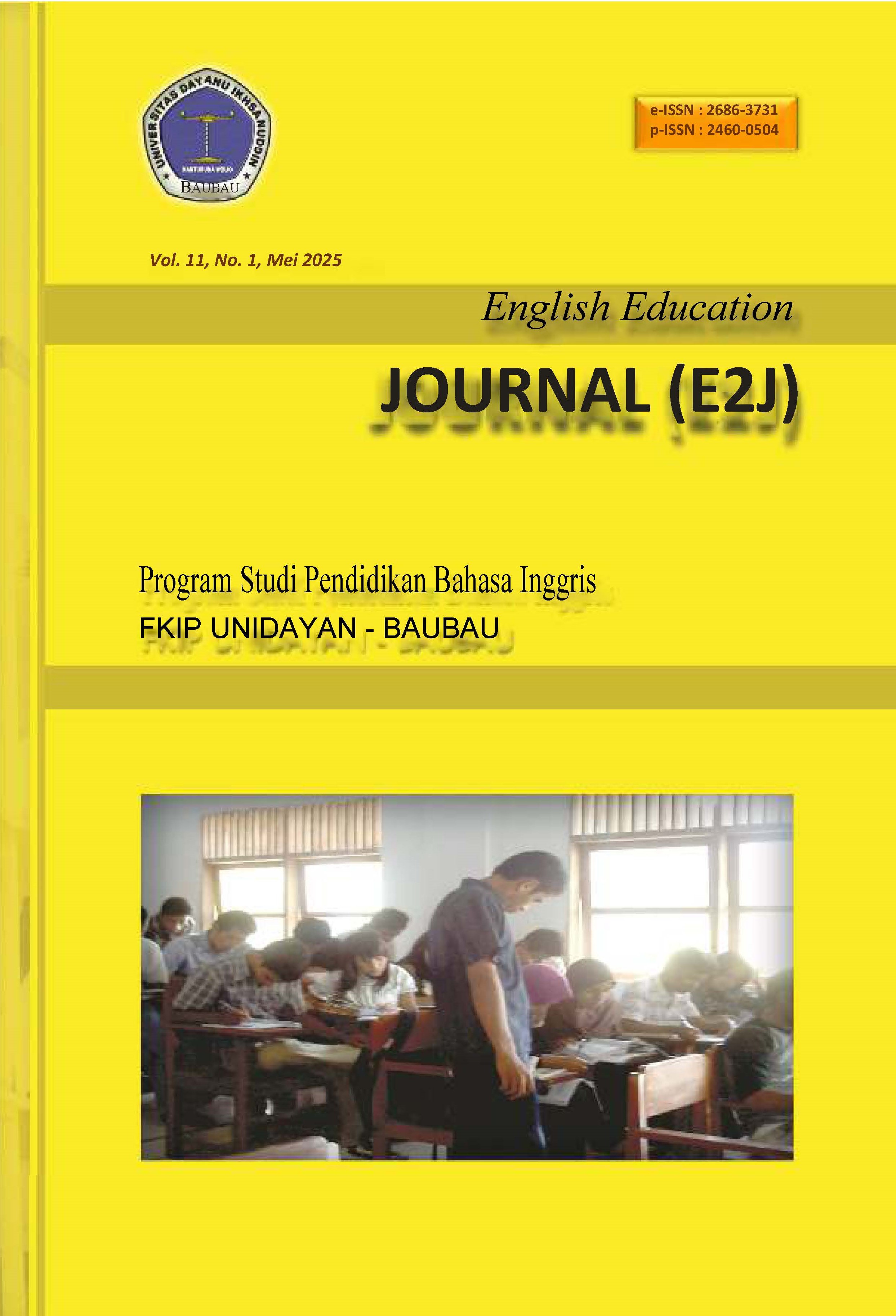CULTURAL EXPRESSIONS IN PARENTING: FIGURATIVE LANGUAGE IN THE CIA-CIA LANGUAGE FOR EDUCATING CHILDREN IN WABULA DISTRICT
DOI:
https://doi.org/10.55340/e2j.v11i1.1862Keywords:
figurative language, cultural expressions, Cia-Cia language, parenting, cognitive development, local language educationAbstract
This qualitative study explores the role of cultural expressions, specifically figurative language in the Cia-Cia language, used by parents to educate their children in Wabula District, Buton Regency. The study aims to identify (1) the types of figurative expressions embedded in daily parent-child communication and (2) their influence on children's cognitive development. Data were gathered through naturalistic observation and semi-structured interviews with four parents who frequently use Cia-Cia in household interactions. The findings reveal that similes, hyperboles, idioms, and personifications are commonly used—often unconsciously—to communicate values, emotions, and abstract concepts. These figurative expressions not only enrich the children’s linguistic input but also facilitate imagination, critical thinking, and the internalization of cultural norms. The study highlights the educational potential of local language expressions in fostering both cognitive growth and cultural identity. Increasing parental awareness of the pedagogical power of figurative language could enhance intentional teaching practices within local cultural contexts
Downloads
References
L. Cameron, Metaphor and Talk in Educational Discourse. London: Bloomsbury Publishing, 2020.
K. Chris, “Ulrich J. Frey, Charlotte Störmer & Kai P. Willführ (Eds.), The Origins of Symbolic Culture,” in Homo Novus: A Human Without Illusion, Berlin/New York: Springer, 2010, pp. 193–211.
K. Chris, “Puzzles and mysteries in the origin of language,” Language and Communication, vol. 50, pp. 12–21, 2016. [Online]. Available: https://doi.org/10.1016/j.langcom.2016.09.002
F. L. Cole, “Content analysis: Process and application,” Clinical Nurse Specialist, vol. 2, no. 1, pp. 53–57, 1988.
B. Dancygier and E. Sweetser, Figurative Language. Cambridge: Cambridge University Press, 2014.
R. W. Gibbs, Embodiment and Cognitive Science. Cambridge: Cambridge University Press, 2006.
S. Glucksberg, Understanding Figurative Language: From Metaphors to Idioms. Oxford: Oxford University Press, 2001.
A. S. Hornby, Oxford Advanced Learner’s Dictionary of Current English, 6th ed. Oxford: Oxford University Press, 2000.
C. Knight, “Language co-evolved with the rule of law,” in The Evolution of Language: Proceedings of the 6th International Conference (EVOLANG6), Rome, Italy, 12–15 April 2006, A. Cangelosi, A. D. M. Smith, and K. Smith, Eds. New Jersey: World Scientific Publishing, 2006, pp. 168–175.
K. Krippendorff, Content Analysis: An Introduction to Its Methodology. London: Sage, 1980.
G. Lakoff and M. Johnson, Metaphors We Live By, 2nd ed. Chicago, IL: University of Chicago Press, 2003.
Y. S. Lincoln and E. G. Guba, Naturalistic Inquiry. Beverly Hills, CA: Sage Publications, 1985.
M. B. Miles and A. M. Huberman, Qualitative Data Analysis: An Expanded Sourcebook, 2nd ed. Thousand Oaks, CA: Sage Publications, 1994.
M. L. Rowe and A. Weisleder, “Language development in early childhood: Research and practice,” Annual Review of Applied Linguistics, vol. 40, pp. 77–94, 2020.
M. Sandelowski, “Whatever happened to qualitative description?,” Research in Nursing & Health, vol. 23, no. 4, pp. 334–340, 2000.
M. Tomasello, Becoming Human: A Theory of Ontogeny. Cambridge, MA: Harvard University Press, 2019.
UNESCO, “Intangible cultural heritage and indigenous languages,” 2022. [Online]. Available: https://ich.unesco.org
L. S. Vygotsky, Mind in Society: The Development of Higher Psychological Processes. Cambridge, MA: Harvard University Press, 1978.
Downloads
Published
How to Cite
Issue
Section
License
Copyright (c) 2025 English Education Journal

This work is licensed under a Creative Commons Attribution-ShareAlike 4.0 International License.






















